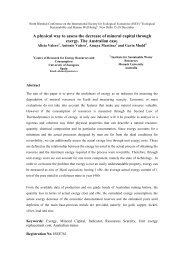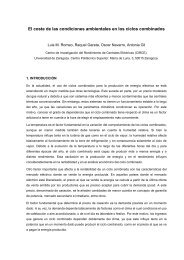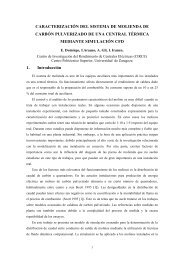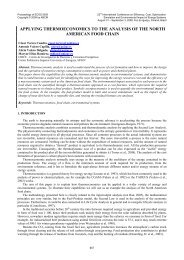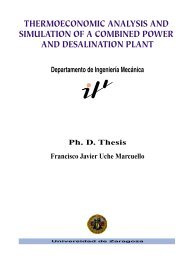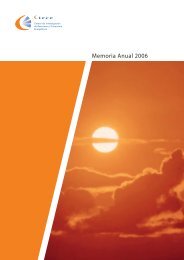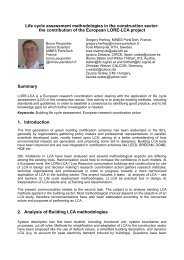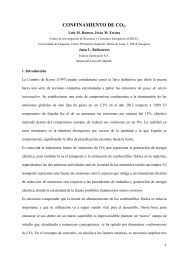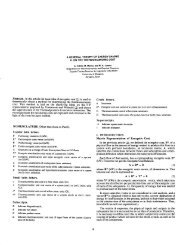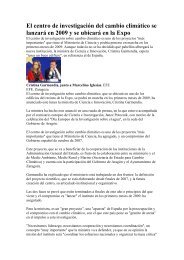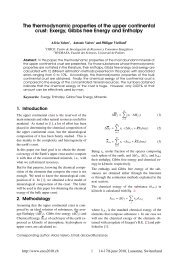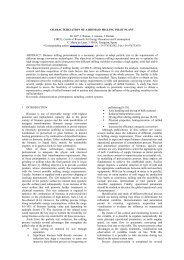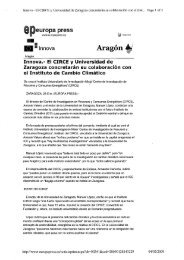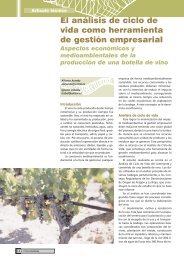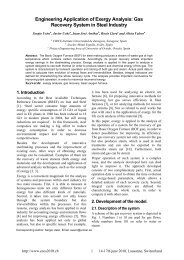towards an international legal reference environment
towards an international legal reference environment
towards an international legal reference environment
Create successful ePaper yourself
Turn your PDF publications into a flip-book with our unique Google optimized e-Paper software.
that exergy, assuming that the <strong>reference</strong> species behave<br />
as components of <strong>an</strong> ideal solution. Hence, Eq.<br />
2 c<strong>an</strong> be applied also in this case.<br />
The evaluation of the st<strong>an</strong>dard molar concentration<br />
of solid R.S. in the external layer of the Earth’s crust<br />
is difficult. In past geochemical publications we c<strong>an</strong><br />
only find a me<strong>an</strong> mass concentration of particular<br />
chemical elements <strong>an</strong>d some information about the<br />
chemical compounds containing the considered elements.<br />
Hence, the best considered way so far to obtain<br />
the st<strong>an</strong>dard molar concentration of R.S. in the<br />
solid <strong>environment</strong>, has been with following equation<br />
suggested by Szargut in [12]:<br />
z0i = 1<br />
n0i ci M0<br />
li<br />
where:<br />
n0i me<strong>an</strong> molar concentration (in mol/kg) of<br />
the i-th element in the continental part of the<br />
Earth’s crust,<br />
number of the atoms of i-th element in the<br />
li<br />
molecule of the <strong>reference</strong> species,<br />
(3)<br />
ci fraction of the i-th element appearing in the<br />
form of <strong>reference</strong> species,<br />
M0 me<strong>an</strong> molecular mass of the upper layer of<br />
the continental part of Earth’s crust.<br />
The <strong>reference</strong> reactions of the elements having solid<br />
R.S. contain usually the gaseous R.S. Sometimes<br />
appear also solid <strong>reference</strong> species. For example,<br />
the solid R.S. of Mg is Mg3Si4O10(OH)2 the<br />
<strong>reference</strong> reaction for the element Mg has a form:<br />
3 Mg+4 SiO2 + 1,5 O2 + H2O = Mg3Si4O10(OH)2<br />
In such case the st<strong>an</strong>dard chemical exergy of the<br />
appearing solid <strong>reference</strong> subst<strong>an</strong>ce should be<br />
calculated prior to the calculation of the chemical<br />
exergy of the considered element.<br />
Discussion of the variables used<br />
The me<strong>an</strong> molar concentration of the elements in<br />
the upper continental crust n0i, used in Szargut [12],<br />
was the recommended by Pol<strong>an</strong>ski <strong>an</strong>d Smulikowski<br />
[21]. R<strong>an</strong>z [13] used updated values mainly from<br />
Taylor <strong>an</strong>d McLenn<strong>an</strong> [22], [23]. For the elements:<br />
Br, C, Cl, F, S, Pt, Pu, Ra, Rh, Ru, Te, I, Hg <strong>an</strong>d N,<br />
Taylor <strong>an</strong>d Mclenn<strong>an</strong> did not provide <strong>an</strong>y information,<br />
therefore, R<strong>an</strong>z used the values given by Wedepohl<br />
[24] for S, Br, C, F, I, Hg, N <strong>an</strong>d for the remainig<br />
elements, the values used by Szargut [12].<br />
Some authors like Pl<strong>an</strong>k <strong>an</strong>d L<strong>an</strong>gmuir [25] basing<br />
on their studies on marine sediments, suggested already<br />
in 1998 some revisions of the estimated values<br />
by Taylor <strong>an</strong>d McLenn<strong>an</strong> [22], [23] for Nb, Cs,Ti,<br />
Ta. As a consequence, McLenn<strong>an</strong> [26] published<br />
in year 2001 new me<strong>an</strong> molar concentrations of the<br />
upper continental crust for the elements: Sc, Ti, V ,<br />
Co, Ni, Nb, Cs, Pb, Ta. Grigor’ev published in year<br />
2000 [27] the average mineral content of the upper<br />
continental crust obtained through a great number<br />
of qu<strong>an</strong>titative mineralogical <strong>an</strong>alysis of import<strong>an</strong>t<br />
rocks published mainly in the USSR <strong>an</strong>d USA. Recently,<br />
Grigor’ev updated this information; this new<br />
<strong>an</strong>alysis comprises 255 minerals corresponding to<br />
99,13% of the total mineral content of the upper continental<br />
crust. Although Grigor’ev has not published<br />
this information yet, he gave permission to the authors<br />
of this paper, to use it. This valuable information<br />
will allow to obtain directly the st<strong>an</strong>dard molar<br />
concentration of the following 12 <strong>reference</strong> subst<strong>an</strong>ces<br />
in the solid <strong>environment</strong> without using Eq.<br />
3: BaSO4, CaCO3, Au, Fe2O3, Mg3Si4O10(OH)2,<br />
MnO2, SiO2, SrCO3, T hO2, SnO2, TiO2, ZrSiO4.<br />
For the rest subst<strong>an</strong>ces, Eq. 3 must be used, taking<br />
n0i from the latest geochemical publications. First<br />
the values from McLenn<strong>an</strong> [26] completed with<br />
those from Wedepohl [24] will be used. For the remaining<br />
elements not appearing in the latter publications,<br />
n0i used by Szargut [12] will be applied.<br />
The me<strong>an</strong> molecular mass of the upper layer of the<br />
continental part of the Earth’s crust, was first estimated<br />
by Szargut [28]. The obtained value was<br />
M0= 135,5 kg/kmol, applying the following estimation<br />
method: according to the geochemical data, the<br />
me<strong>an</strong> concentration values (in mol/kg) of particular<br />
chemical groups or elements in the external layer of<br />
the continental Earth’s crust <strong>an</strong>d the chemical compound<br />
formed from these groups were assumed. The<br />
first considered group was CO2, which appears in<br />
the Earth’s crust mainly in carbonates of Ca, Mg <strong>an</strong>d<br />
Fe. Per 1 mol of (CaO + MgO + FeO) 0,035 mol of<br />
CO2 are present. The group CO2 was partitioned between<br />
the mentioned groups <strong>an</strong>d elements Zn, Cu,<br />
Pb <strong>an</strong>d Cd, appearing also in the form of carbonates.<br />
The group SO3 was partitioned between CaO<br />
<strong>an</strong>d MgO forming sulphates. It was assumed that a<br />
prevailing part of metals (Sn, Co, Mn, Fe, Ni) appears<br />
in form of different oxides (Co2O3, Co3O4,<br />
Fe2O3, Fe3O4). It was also assumed that 8% of



